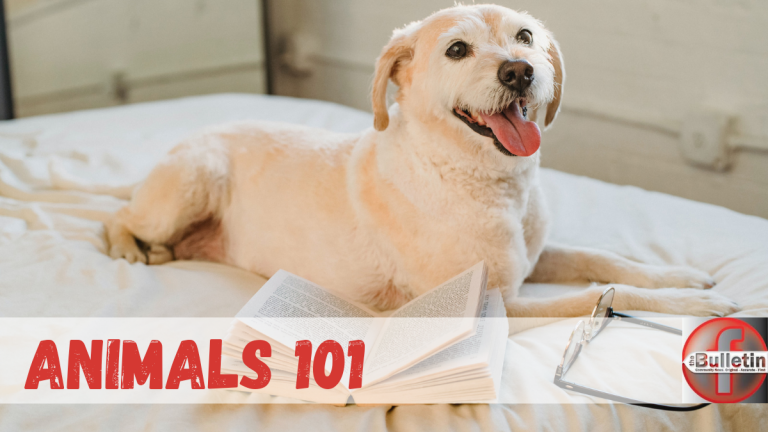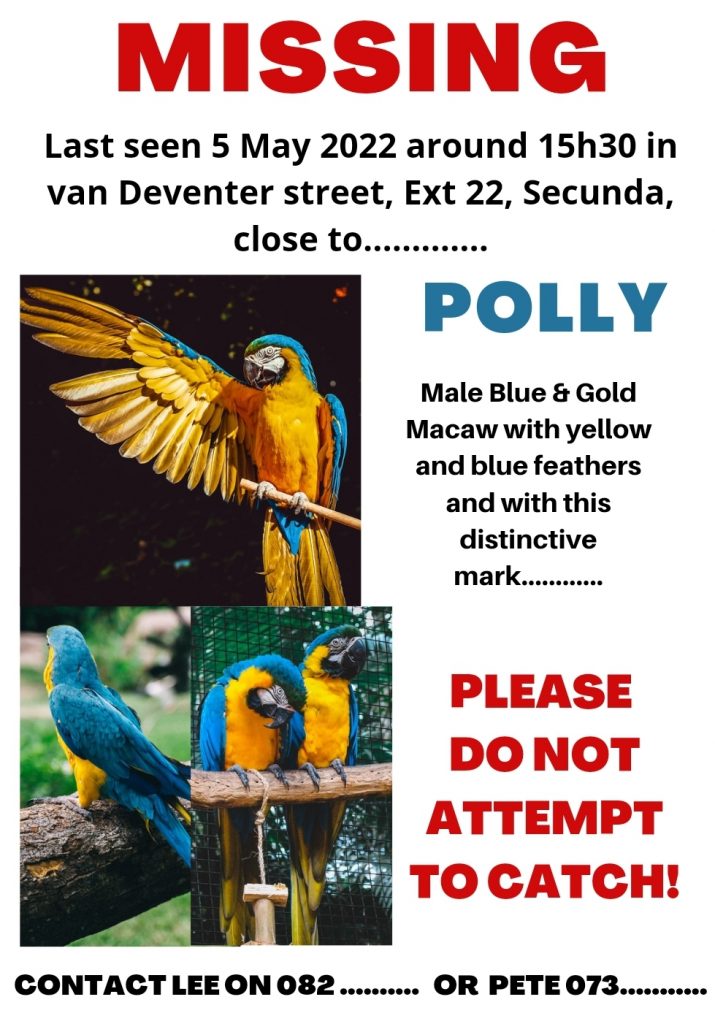
ANIMALS 101 – TIPS ON HOW TO PROCEED IN FINDING AN ESCAPED PARROT
We have recently seen many animals and especially birds lost locally. Prevention is important, but here are some tips when an accident does happen and your animals get out or they fly off.
PREVENTION TIPS
1. Always check that windows and doors are closed when they are out of their cage.
2. Wing clipping should only be done by a qualified professional, but we don’t support it as a rule because they were meant to fly. Remember they can still fly a considerable distance, especially on a windy day.
3. If you take them for outings make sure it is a safe and secure carrier or wear a safe harness.
4. Practice recall and teach them to fly down to you from higher perches, trees, roofs, or on top of stairs.
5. Have a flyer ready. The photo should show the bird in full colour both back and front view and with wings spread if possible. If you leave town and your parrots are in the care of others, make sure they fully understand the recovery process and that they understand to notify you immediately if your bird escapes.
HOW TO PROCEED
1. Start searching as soon as you realize your bird is lost. If you see them fly away, note the direction!
2. Place their cage outside and fill it with his/her favourite treats and fresh water. Leave the cage door open.
3. Canvas the neighbourhood – Most birds are recovered within 3 kilometres of the escape location, so within hours, you need to have everyone within that area know how to contact you. Let your neighbours know that you lost your bird. Walk around the neighbourhood and call his/her name. The best way to do this is to go door to door to every home in the neighbourhood. If you have other birds, take them with you on the search if possible.
4. Distribute flyers and share them on social media and neighbourhood groups with a detailed description of your lost animal and a picture. Include instructions to leave the bird alone and not attempt to recover them and your contact number.
5. Ensure that many are on the lookout.
6. The phone number listed on the flyer should be a fully charged cell phone with service available in the area where your bird was lost. If this is not available the phone should be with a friend or family member who will be able to contact you.
7. You can offer a reward (controversial) for their safe return.

WHAT TO EXPECT
- Even brightly coloured animals blend in amazingly well.
- The bird will most likely start calling within the first 24 hours.
- Days are not counted with 24 hours, but how many nights the parrot has been out.
- DAY 1 is the day of escape whether morning or late in the afternoon.
- DAY 2 is the day after the first night spent out.
FIRST 24 HOURS – Start searching immediately after escape and continue until dusk and resume every morning at dawn. Large parrots are quiet and roost at night making searching at night fairly pointless.
THE NEXT 24 HOURS – If you have not spotted your parrot within the first 24 hours contact local shelters and veterinary hospitals daily and list your bird as missing. Go to shelters, in person, frequently, to see if your bird has been surrendered.
DAY 3 (after the second night out) – By day 3 you should double your flyer area and grow it each day thereafter. The most critical part of recovery is, DON’T GIVE UP!
- Place an ad in your local newspapers.
- Share on social media often with updates on the original post when and where the bird was spotted.
- Inform a bird rescue organization near you.
- List your bird as missing at other lost and found bird websites or social media groups. In our area share on Verlore Diere Secunda (TEKS) group and its WhatsApp group – 081 013 4952.

RECOVERING A LARGE PARROT
Birds instinctively tend to fly when their adrenaline level is high. They also generally fly up to the highest point they can land. However, most pet birds today have never been fully-fledged sadly. While smaller birds can often fly quite easily, larger parrots require more skill to be able to take off, land and navigate. Consequently, if a bird flies to something high, they might lack the skill to fly down. This means that most large parrots who escape their caregivers need to be found quickly and then monitored until they are ready to climb down on their own. Remember your bird will probably have to glide down instead of fly directly down if they can’t climb down.
- Wait until the animal is ready to come down willingly, especially if above arm’s length.
- Food treats and attention by the caregiver are the only tools that should be used to encourage the parrot to come down sooner, rather than later. Do not spook the bird into taking off again as that starts the process all over. So, don’t climb the tree or use any pipes, ladders etc. to get them down. A few cold nights are far less dangerous to the bird than having it fly onto a power line or to a location where you can’t spot it.
- The parrot should be observed from dawn to dusk. The parrot will probably just roost. Food should not be left out or distributed around the location. The goal is for the parrot to climb down to the caregiver. This usually happens on day three. Avoid too many strangers at the location. You want the parrot to focus on its caregiver.
- Watch for signs the parrot is ready to climb down: Fluttering of wings, movement in the tree to ensure a good view of the caregiver, calls to the caregiver when not in view or movement toward the caregiver
- Once the parrot is showing clear signs of being ready to climb down, start passing favourite foods to other spotters around the location in view of the parrot. Make yummy sounds too. Use fairly large visible portions of brightly or strong-smelling foods that the parrot sees as a treat. This should get the parrot fairly excited if it is ready to come down. Continue with the food fest with only the primary caregiver directly at the base where the parrot will need to climb down.
- When you leave and return, start the food fest over again. Most likely, by the end of day three, the parrot will give in and climb down to its caregiver.
- If it is getting late in the day on day 3 and the parrot is looking like it is settling in for the night, try one last shot for that day.
- By day 4 most parrots will climb down to anyone, but for those few holdouts, just continue as on previous days. The parrot will eventually climb down when it is ready.
READ MORE on owning a parrot.
Learn more about parrots from Brainy Birds – Parrot Rescue and Rehabilitation, STAR – St. Louis Avian Rescue.
Keep your pets safe! Next week we will look at the controversy regarding the clipping of domestic bird’s wings.
WHEN YOU KNOW BETTER, DO BETTER!